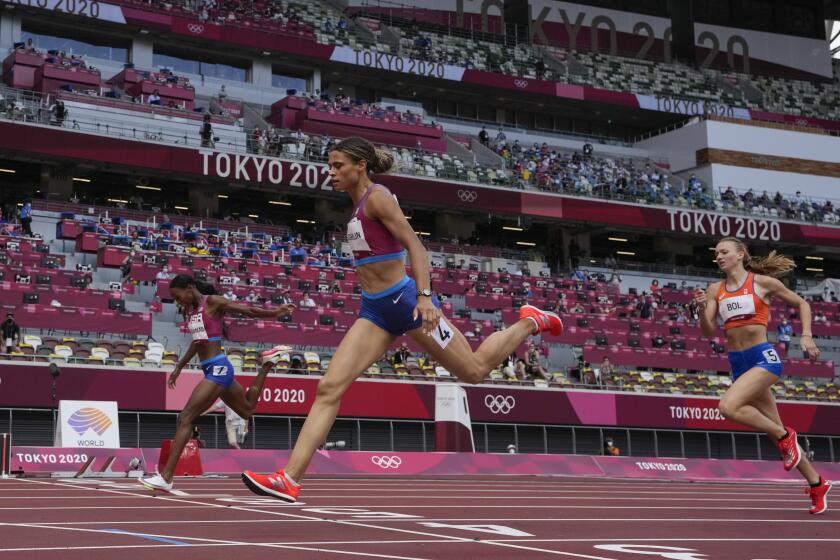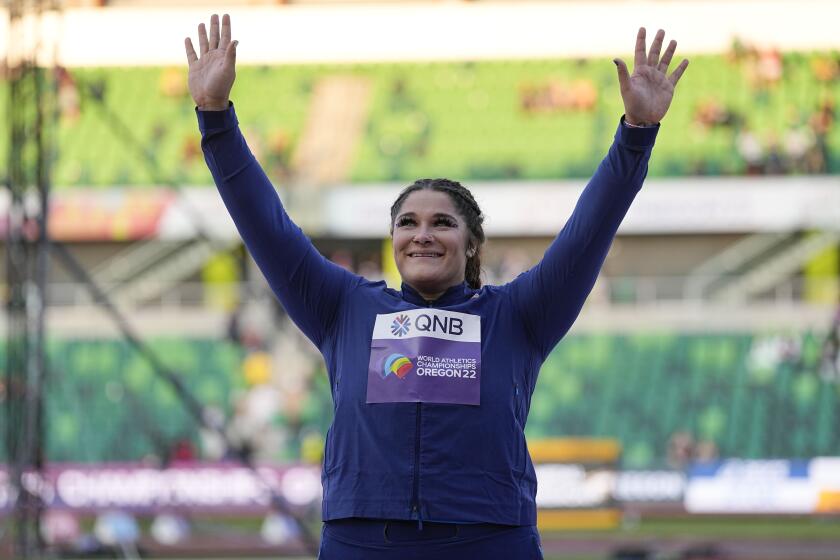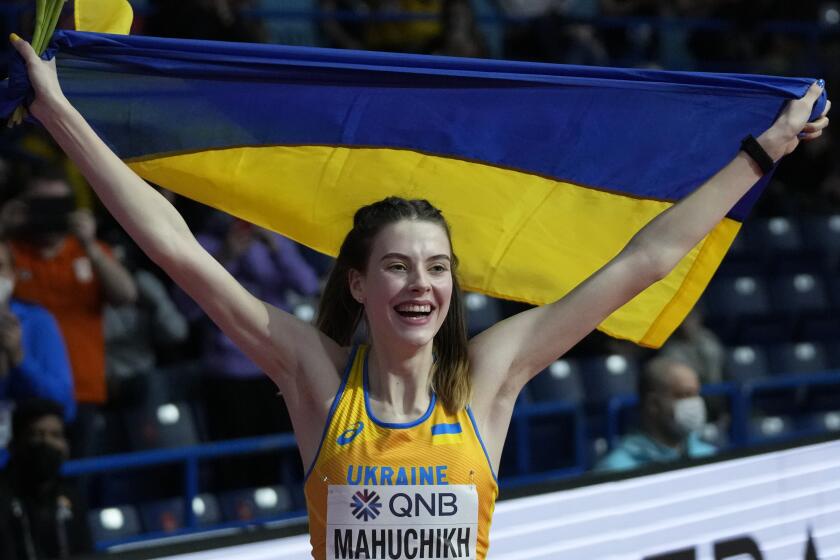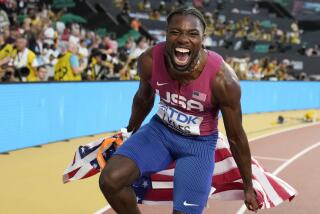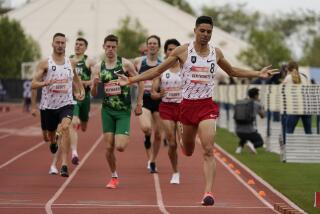Jakob Ingebrigtsen’s finger-wagging showmanship driven by his ‘bad’ urge to win
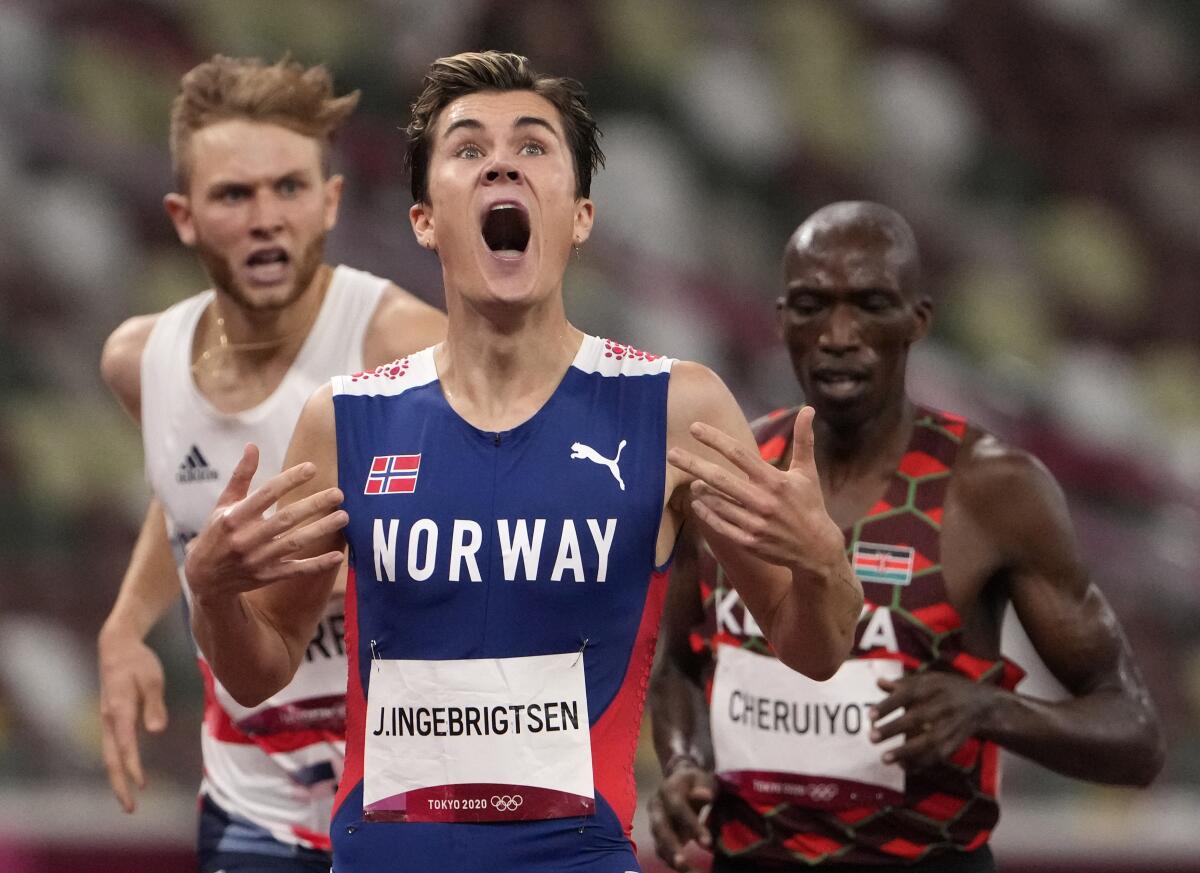
- Share via
EUGENE, Ore. — After he’d crossed the finish line on a warm May evening in San Juan Capistrano, his index finger wagging lest anyone doubt his victory, distance-running sensation Jakob Ingebrigtsen spent the next 45 minutes posing for dozens of teenaged fans’ requests for selfies.
This was Ingebrigtsen in full, a mix of speed, showmanship and comfort in the spotlight that begged the question of nature versus nurture. Within his native Norway, Ingebrigtsen has been a celebrity for the majority of his 21 years through “Team Ingebrigtsen,” a documentary series that followed his family of runners’ hard-charging training for a decade.
In a country of 5 million, some episodes had been watched by as much as one-fifth of the population, said Petter Wallace, the head of content commissioning and sales for NRK, the country’s public-service broadcaster, which aired the show. The outcome of December’s series finale, which chronicled Ingebrigtsen winning the 1,500-meter gold medal in Tokyo last year, had been known for months, yet became one of the series’ most-watched shows.
The world championships begin with what USA Track & Field officials call a critical window for hopes of becoming the fifth-most popular sport in the nation.
“You couldn’t write something like that,” Wallace said. “It’s like a journey that, if that had been a drama series, it probably would have been rejected because it’s too unlikely.”
The California teenagers hovering near the star not much older than them, with tattoos speckling his legs and arms and an impeccable part in his brown hair, saw what so many of the show’s viewers did: a runner who had reached distance-running’s mountaintop. Yet even in a life as public as Ingebrigtsen’s, what no one on the outside could observe had been the inner melancholy he felt atop the summit.
“It’s really strange,” he said in May, “because I trained for that specific race for basically my whole life so there’s — the peak is really high, but also, right after you peak, there’s a big low because I’ve done it. So what’s the meaning of going back and training and do all the s— work that’s needed to get back in the same shape?
“But I’m still competitive, and that’s the bad part, for me. I just can’t throw in the towel and say that I’m finished. I want to win the world championship as well, and when I’m this fast, it would have been stupid not to go after some records.”
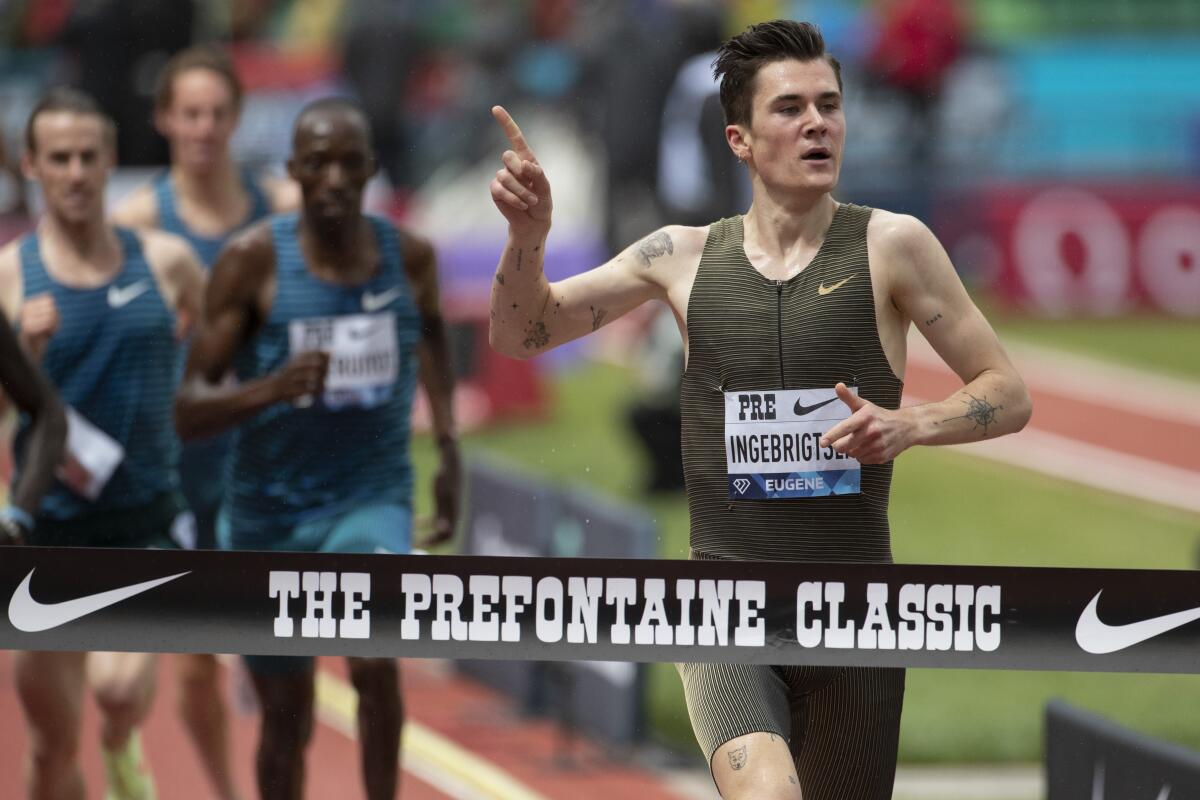
There was an urge at times to do something else.
“Sometimes,” he said, “I just want to be a mechanic and watch my dogs.”
Ultimately, though, in the months following Tokyo, his preternatural urge to win kicked into gear. The search for what he called his “next mountain” to climb has now brought him here, to a track in the shadow of the Coburg Hills, and Tuesday’s 1,500-meter world championships final inside Hayward Field, where he will take the track as one of the sport’s can’t-look-away leading men.
Ingebrigtsen, who will also race the 5,000 in these championships, will be favored to add another gold medal to an already glittering resume.
At just 16 he became the youngest to ever break four minutes in the mile in a 2017 race also at Hayward Field. His Olympic-record time of 3 minutes 28.32 seconds is the eighth fastest ever over 1,500 meters and his mile best of 3:46.46 is sixth fastest.
Devon Allen was disqualified from the men’s 110-meter hurdles at the track and field world championships by the slimmest of margins after a false start.
The fascination extends beyond his speed. Asked in San Juan Capistrano what had happened during his silver-medal performance in March’s world indoor championships, he said he had been unlucky to contract COVID-19 shortly before the race because “I think if I was healthy,” he said, “I would have won by 100 meters.” Three weeks later after winning the mile by a wide margin in Eugene’s Prefontaine Classic, he said that “you can’t be disappointed with people not being better.”
Viewers of “Team Ingebrigtsen” would not have been surprised by such candor. Wallace recalled watching the prodigy, when 12, tell his family he would win a world title, “and he was in a family where you know, they believed what he said.” One Norwegian journalist, who asked not to be named, said that the qualities are more American than Norwegian.
“They are controversial because in Norway, athlets [sic] are supposed to be humble, boring and only say the right things on TV,” wrote one commenter of LetsRun, a popular running site, on one of the many threads dedicated to “Team Ingebrigtsen.” “Still, we cant [sic] help being very proud of have such talents.”
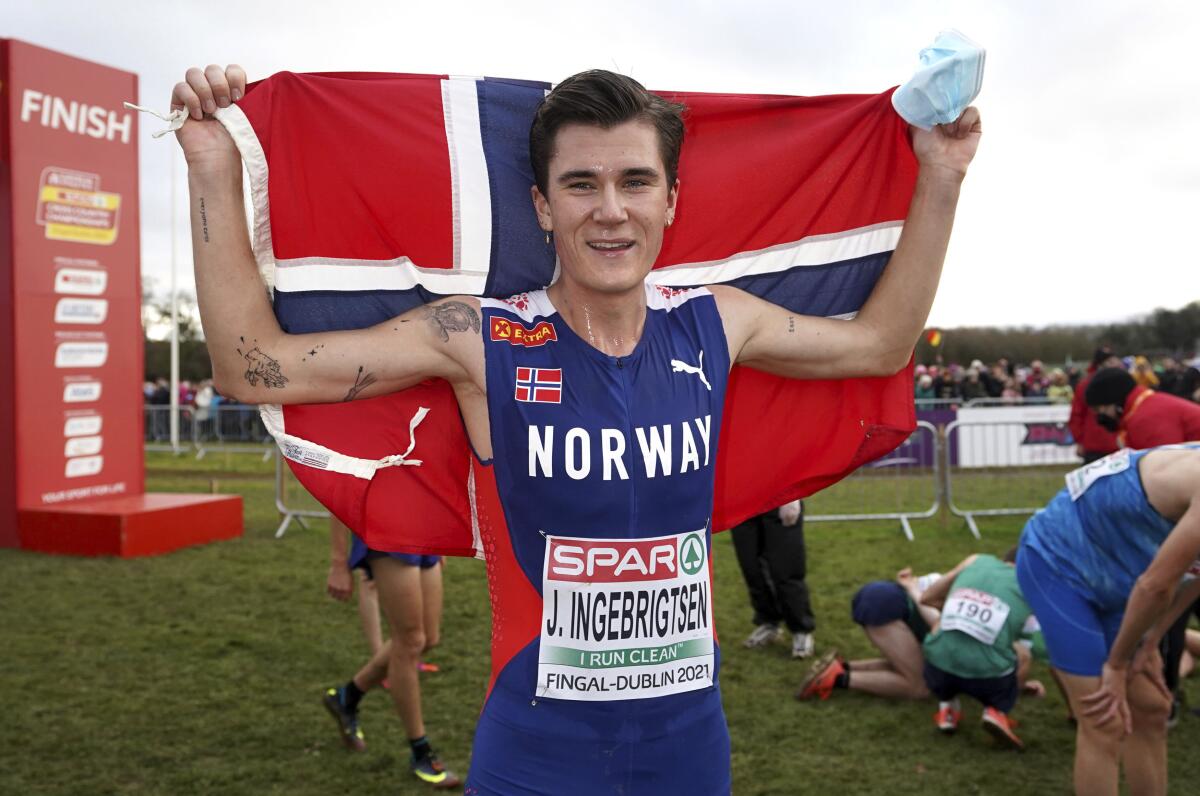
“In a way,” Wallace said, “he has this boyish charm that everybody loves about him. Maybe someone who was equally brash like that would not be very much liked. But he is deeply loved by the audience here.”
The television executive had been skeptical when a production company that had filmed the family by then for two years approached NRK, a network whose ubiquity Wallace likened to the BBC in Great Britain. Sports series were not as popular as dramas. Yet viewers came to devour the complicated, funny, unpredictable dynamic of Gjert, the father and self-made coach, and mother, Tone, and their seven children in their hometown on the North Sea. Two of Ingebrigtsen’s older brothers — Henrik, 31, and Filip, 29 — are also international competitors.
The American women are coming off an Olympics in which they won 15 medals only 15 years after winning six. Who and what is driving this talent surge?
Ingebrigtsen described the experience as obtrusive but enjoyable, yet he also grew frustrated when cameras would follow him to his room long after formal interviews had ended during major championships. He had wanted zero distractions.
“We’re trying to rewrite history,” he said in July. “But the first thing and the most important thing is to be hungry. I want to win.”
It was why he’d dashed off in San Juan Capistrano to first place when he could have coasted toward a qualifying time.
“There’s good and bad things about being competitive,” he said. “But I don’t want to lose.”
Ukraine’s track and field athletes believe there is power in claiming territory, whether around battered cities or atop an awards podium.
Cole Hocker, a top American 1,500-meter runner, said in May that he had not watched the Ingebrigtsen’s docu-series, but legions of American fans and other competitors have. Running message boards are filled with threads to links of English-subtitled episodes and pointed critiques of the family’s unceasing ambition.
A significant plot twist occurred last winter, after the footage stopped rolling. The brothers are no longer coached by their father. The topic can be sensitive. A World Athletics official cautioned journalists not to broach it before a group Zoom interview with Ingebrigtsen in July. When he was asked, he said that Henrik and Filip were heavily involved in his training but that he held the “final word.”
Much of their training in the spring took place at altitude in Flagstaff, Ariz. From there Jakob, Henrik and a few other staffers traveled to Orange County in May for his 5,000 in San Juan Capistrano. After he’d won, he was mobbed my another group of teens who hadn’t heard him so matter-of-factly describe the way his Tokyo gold had not delivered the satisfaction he expected.
Perhaps that feeling will change with a second major global championship gold medal in as many years. He’d like to find out for himself.
More to Read
Go beyond the scoreboard
Get the latest on L.A.'s teams in the daily Sports Report newsletter.
You may occasionally receive promotional content from the Los Angeles Times.

